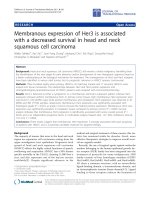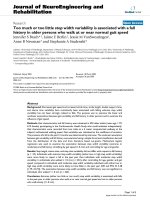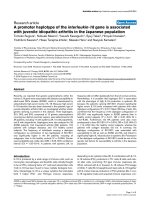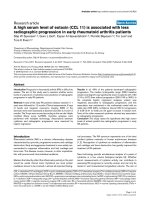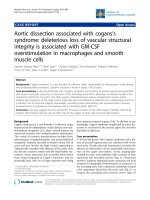Breastfeeding is associated with enhanced learning abilities in school-aged children
Bạn đang xem bản rút gọn của tài liệu. Xem và tải ngay bản đầy đủ của tài liệu tại đây (807.14 KB, 7 trang )
Kim et al. Child Adolesc Psychiatry Ment Health (2017) 11:36
DOI 10.1186/s13034-017-0169-0
RESEARCH ARTICLE
Child and Adolescent Psychiatry
and Mental Health
Open Access
Breastfeeding is associated
with enhanced learning abilities in school‑aged
children
Johanna Inhyang Kim1, Bung‑Nyun Kim2, Jae‑Won Kim2, Soon‑Beom Hong3, Min‑Sup Shin2,3, Hee Jeong Yoo2,4
and Soo‑Churl Cho5*
Abstract
Objective: The majority of studies on the associations between breastfeeding and cognitive functioning have
focused on IQ, with only a few investigating learning skills, and none of the latter adjusting for maternal IQ. We exam‑
ined the association between breastfeeding and learning abilities in school-aged children using a cross-sectional
design.
Methods: We recruited 868 children, aged 8–11 years and parents completed the Learning Disability Evaluation
Scale (LDES). Multivariable linear regression models were used and age, gender, area of residence, annual family
income, maternal education, and maternal age at delivery, were included as covariates. Maternal IQ was added to
further adjust for the effects of maternal cognitive ability. Path analysis was conducted to investigate the mediation
effect of maternal IQ between breastfeeding and learning skills.
Results: Children who were ever-breastfed had higher learning quotient scores on the LDES (p = 0.001) as well
as higher scores on subscales related to speaking (p = 0.001), reading (p = 0.005), writing (p = 0.004), spelling
(p = 0.003), and mathematical calculation (p = 0.003) than the never-breastfed participants. All of these variables
remained significant after adjusting for gestational and socioeconomic factors and for maternal IQ as covariates. The
path analysis showed that breastfeeding had both indirect and direct effects on the learning quotient.
Conclusions: The results suggest that breastfeeding is positively associated with learning skills in school-aged
children.
Keywords: Breastfeeding, Intelligence, Learning, Maternal cognition
Background
Previous studies have reported that breastfeeding is
linked to enhanced cognitive performance in childhood
including superior attentional skills and a higher intelligence quotient (IQ) relative to children who were not
breastfed [1]. A meta-analysis reported that breastfed
children had an adjusted cognitive advantage of 3.15
IQ points compared to formula-fed children [2]. This
positive effect of breastfeeding on IQ was also observed
*Correspondence:
5
Armed Forces Capital Hospital, 81 Bun‑ji, 177 Bun‑gil, Saemail‑ro,
Bundang‑gu, Seongnam, Kyunggi‑di 13573, Republic of Korea
Full list of author information is available at the end of the article
in a randomized trial, which reported an average 7.5
IQ points increase in children who were allocated to
breastfeeding promotion groups [3]. However, given
that breastfeeding mothers are more likely than nonbreastfeeding counterparts to be older, have a higher
socioeconomic status (SES), and engage in behaviors that
stimulate child development [2, 4], some studies have
reported that the association between breastfeeding and
IQ is attenuated when SES variables and maternal IQ are
controlled for [5]. For example, a meta-analysis reported
that the 4-point increase of IQ in breastfed subjects relative to formula-fed subjects was attenuated to the point
of non-significance after adjustment for maternal IQ
[6]. This study concluded that breastfeeding has little or
© The Author(s) 2017. This article is distributed under the terms of the Creative Commons Attribution 4.0 International License
( which permits unrestricted use, distribution, and reproduction in any medium,
provided you give appropriate credit to the original author(s) and the source, provide a link to the Creative Commons license,
and indicate if changes were made. The Creative Commons Public Domain Dedication waiver ( />publicdomain/zero/1.0/) applies to the data made available in this article, unless otherwise stated.
Kim et al. Child Adolesc Psychiatry Ment Health (2017) 11:36
no effect on the intelligence of children [6]. Hence, it is
important to consider the effect of maternal IQ in investigating the relationship between breastfeeding and children’s cognitive functioning.
Most of the studies investigating breastfeeding and
cognitive abilities have focused on the child’s IQ,
whereas only a few have investigated academic performance or learning skills, and these studies have produced inconsistent results. A previous study reported
that, after adjustment for SES factors, children who
were breastfed showed a significant test score advantage in reading and mathematics compared to those
who were not [7]. Another study yielded negative
results, reporting that the home learning environment
was more important than predominant breastfeeding
in determining early-age math and reading skills [8].
Moreover, some studies have assessed academic performance using teachers’ reports, whereas others have
used standardized tests that measure learning skills in
specific cultural contexts [7, 9]. None have used a standardized tool that can be widely applied to children of
various cultural backgrounds. Furthermore, none of
these studies have adjusted for the effects of maternal
IQ; considering the highly predictive value of maternal
IQ on children’s cognitive abilities, this may have confounded the results.
In the present study, we investigated the relationship
between breastfeeding and learning abilities, using the
Learning Disability Evaluation Scale (LDES), a widely
used screening instrument to evaluate various learning
skills, screen for learning disabilities, and calculate the
learning quotient (LQ). We hypothesized that the association between breastfeeding and learning abilities would
be significant, even after adjusting for various developmental and SES variables and for maternal IQ.
Methods
Participants
This study used a cross-sectional design and was conducted as a 3-year project whose detailed protocols have
been described elsewhere [10, 11]. Third and fourth
graders (aged 8–11 years) were recruited in five administrative regions in South Korea, including Seoul and
Seongnam (urban districts), Incheon and Ulsan (industrial districts) and Yeoncheon (rural district). We selected
the two or three schools in each region that were most
representative of the local demographics, and letters of
invitation were sent to the parents of the participants
(n = 1712). Schools in the center of each region were
chosen, to reflect a microcosm of each region. Detailed
information was provided to all parents, and written
informed consent was obtained prior to enrollment. The
Page 2 of 7
study protocol was approved by the institutional review
board of the Seoul National University Hospital.
The participants’ parents filled out questionnaires that
contained items inquiring about gestational, socioeconomic and developmental factors. Infant feeding methods were investigated using an item inquiring whether
the child had ever been breastfed. Maternal IQ was
measured using the short form of the Korean Wechsler
Adult Intelligence Scale under the guidance of a trained
examiner who was blind whether the children had been
breastfed or not. Short forms are known to correlate well
with full scale IQ [12].
Measurement of learning abilities
Parents of the participants completed the LDES, a parent-rated scale consisting of 88 items [13]. Items yield
scores on a scale of 1–3, and results are presented as
age-adjusted scores on seven subscales pertaining to listening, thinking, speaking, reading, writing, spelling and
mathematical calculation. Higher scores indicate better
performance, and the subscores are summed to calculate
an overall LQ. The Korean version of the LDES has been
age-standardized and has been found to have fair reliability and validity [14].
Statistical analyses
The demographic and clinical characteristics of the everbreastfed and never-breastfed participants, as well as the
participants who were excluded from the analysis, were
compared using independent t tests for continuous variables and Chi square tests for categorical variables.
We analyzed the association between LDES subscale scores and breastfeeding using multivariable linear
regression models. Graphic and residual analyses were
performed to assess modelling assumptions. Univariable regression was used to investigate the association
between breastfeeding and demographic and clinical
factors (age [years], gender [male or female], area of residence [urban, industrial or rural], annual family income
[$25,000 and higher or below $25,000], maternal education level [years], birth weight [kg], gestational age at birth
[weeks], age of mother at birth [years], and maternal IQ).
We included those variables found to be statistically significant (p < 0.10) as covariates. None of the multivariable
linear regression models revealed multicollinearity among
the independent variables. A path analysis was conducted
to investigate the direct effect and also the indirect effect
mediated by maternal IQ of breastfeeding on LQ scores.
All statistical analyses were performed using SPSS
(version 22.0; SPSS Inc., Chicago, IL, USA) and AMOS
(version 18.0; SPSS Inc., Chicago, IL, USA). Statistical
significance was defined as a p value <0.05.
Kim et al. Child Adolesc Psychiatry Ment Health (2017) 11:36
Page 3 of 7
Results
Among the initial 1712 participants we solicited, 1089
(response rate 63.6%) agreed to participate in the study,
and data related to breastfeeding and the LDES was
obtained for 868 (79.7%; 453 boys and 415 girls, mean
age 9.0 ± 0.7) children. Among these 868 participants,
516 (59.4%) were ever-breastfed during infancy and 352
(40.6%) were never-breastfed.
The demographic and clinical characteristics of the
ever-breastfed and never-breastfed participants included
in the study, as well as the 221 who were excluded from
the analyses, are presented in Table 1. Maternal IQ and
birth weight were higher in the ever-breastfed group
compared to the never-breastfed group. There were no
differences between the two groups with regard to other
demographic and SES characteristics.
The association of potential covariates with breastfeeding is presented in Table 2. Among the significant
factors (p < 0.10), age, gender, area of residence, annual
family income, years of maternal education, and age of
mother at birth were included as covariates in Model 2
and maternal IQ was additionally included in Model 3 to
adjust for maternal cognition.
The association between LDES subscale scores and
breastfeeding is presented in Table 3. In Model 1, the
ever-breastfed participants had higher overall LQ scores
(p = 0.001) as well as higher scores on subscales related
to speaking (p = 0.001), reading (p = 0.005) writing
(p = 0.004), spelling (p = 0.003) and mathematical calculation (p = 0.003). After adjusting for age, gender, area
of residence, annual family income, years of maternal
Table 2 Association of demographic and clinical characteristics with learning quotient
Characteristic
B (SE)
95% CI
p value
Age
−1.35 (0.48)
−2.30, −0.40
0.005
2.25, 4.91
<0.001
Urban
R
R
R
Industrial
−0.54 (0.76)
−2.03, 0.94
0.473
−3.17 (0.71)
−4.55, −1.78
<0.001
Gender
3.58 (0.68)
Area of residence
Rural
−1.80 (0.98)
Annual family income
Years of maternal education
0.64 (0.16)
Birth weight
0.41 (0.74)
Gestational age at birth
−0.40 (0.36)
Age of mother at birth
−0.16 (0.09)
Maternal IQ
0.13 (0.03)
−3.71, 0.12
0.067
0.33, 0.96
<0.001
−1.03, 1.86
0.574
−0.34, 0.02
0.082
−0.91, 0.11
0.122
0.07, 0.19
<0.001
education, birth weight, gestational age at birth, and
maternal age at birth, the same variables as those in
Model 1 emerged as significant, with ever-breastfed
children having higher LQ scores (p = 0.004) than
never-breastfed children as well as having higher scores
on subscales related to speaking (p = 0.001), reading
(p = 0.011), writing (p = 0.012), spelling (p = 0.006), and
mathematical calculation (p = 0.028). When maternal IQ
was added as a covariate in Model 3, all of these variables
remained significant, i.e., LQ scores (p = 0.005) as well as
subscores for speaking (p = 0.001), reading (p = 0.015),
writing (p = 0.022), spelling (p = 0.013), and mathematical calculation (p = 0.026). The effect sizes (Cohen’s f2)
Table 1 Demographic and clinical characteristics of the breastfed and non-breastfed participants, and of participants
excluded from analyses
Characteristics
Age (years), mean (SD)
Ever-breastfed
participants
(n = 516)
Never-breastfed
participants
(n = 352)
p value
Excluded
participants
(n = 221)
p value
9.1 (0.7)
9.0 (0.7)
0.337
9.1 (0.7)
0.041
Sex (male), N (%)
267 (51.7)
186 (52.8)
0.751
118 (53.4)
0.749
Annual family income >$2500, N (%)
311 (60.9)
229 (65.4)
0.173
81 (59.6)
0.480
Paternal education, years, mean (SD)
13.8 (2.2)
13.8 (2.2)
0.928
13.2 (2.3)
Maternal education
13.3 (2.0)
13.1 (2.1)
0.118
12.8 (2.2)
Region
0.098
0.001
0.043
<0.001
Urban
220 (42.6)
128 (36.4)
115 (52.0)
Industrial
214 (41.5)
152 (43.2)
56 (25.3)
82 (15.9)
72 (20.5)
3.3 (0.5)
3.2 (0.5)
<0.001
3.2 (0.5)
0.886
28.3 (3.8)
28.4 (3.8)
0.875
28.9 (4.9)
0.245
108.1 (11.4)
106.4 (11.9)
0.039
108.4 (10.1)
0.886
39.8 (1.2)
39.7 (1.6)
0.241
39.8 (0.8)
0.213
Rural
Birth weight
Maternal age at birth
Maternal IQ
Gestational age at birth
SD standard deviation, IQ intelligence quotient
50 (22.6)
Kim et al. Child Adolesc Psychiatry Ment Health (2017) 11:36
Page 4 of 7
Table 3 Association of LDES scores with breastfeeding
LDES score,
mean (SD)
Ever-breastfed NeverModel 1
participants
breastfed
(N = 516)
participants Β (95% CI)
(N = 352)
Model 2a
p value
Β (95% CI)
Model 3b
p value Β (95% CI)
Effect size
(Model 3)
p value
LDES
Listening
11.4 (2.2)
11.2 (2.5)
0.28 (−0.04, 0.60) 0.085
0.35 (−0.71, 0.57) 0.126
0.30 (−0.04, 0.63) 0.080
0.056
Thinking
11.4 (1.8)
11.2 (2.1)
0.23 (−0.04, 0.50) 0.089
0.19 (−0.70, 0.50) 0.150
0.19 (−0.08, 0.46) 0.165
0.041
Speaking
11.7 (2.0)
11.2 (2.3)
0.49 (0.21, 0.78)
0.001
0.50 (0.21, 0.79)
0.001
0.49 (0.20, 0.79)
0.001
0.058
Reading
11.3 (2.1)
10.8 (2.4)
0.44 (0.14, 0.74)
0.005
0.38 (0.67, 0.99)
0.011
0.37 (0.07, 0.67)
0.015
0.076
Writing
11.3 (2.0)
10.9 (2.4)
0.43 (0.14, 0.73)
0.004
0.47 (0.08, 0.65)
0.012
0.34 (0.05, 0.63)
0.022
0.101
Spelling
10.9 (2.3)
10.4 (2.8)
0.52 (0.18, 0.86)
0.003
0.46 (0.13, 0.78)
0.006
0.42 (0.09, 0.76)
0.013
0.117
Mathematical
calculation
11.8 (1.5)
11.4 (2.1)
0.37 (0.12, 0.61)
0.003
0.26 (0.03, 0.50)
0.028
0.27 (0.03, 0.51)
0.026
0.048
108.8 (9.0)
105.6 (11.4)
2.23 (0.86, 3.59)
0.001
1.97 (0.65, 3.30)
0.004
1.95 (0.59, 3.31)
0.005
0.092
Learning
quotient
LDES Learning disability evaluation scale, SD standard deviation
a
Covariates include age, gender, area of residence, annual family income, years of maternal education, and age of mother at birth
b
Covariates include age, gender, area of residence, annual family income, years of maternal education, age of mother at birth, and maternal IQ
for each subscale in Model 3 ranged from 0.041 to 0.117,
indicating small effect sizes.
In the path analysis, the degree of freedom was 0,
indicating a saturated model. The results of the path
model were shown in Fig. 1. Breastfeeding had both
direct and indirect effect on the LQ. Breastfeeding was
significantly associated with maternal IQ (β = 0.072,
p = 0.039), and maternal IQ was significantly associated with LQ scores (β = 0.145, p < 0.001). The
direct effect between breastfeeding and LQ was 0.098
(p = 0.003), and the indirect effect was 0.010. The
squared multiple correlation was 0.03 in the LQ, indicating that this model accounted for 3% of variance of
the LQ.
Fig. 1 Path model of breastfeeding and the learning quotient, medi‑
ated by maternal IQ. IQ intelligence quotient. *p < 0.05, **p < 0.01,
***p < 0.001
Discussion
This study found that those who were ever-breastfeed
had a positive advantage on learning skills including
speaking, reading, writing, spelling and mathematical
calculation compared to those that were never-breastfed,
even after controlling for various gestational and socioeconomic variables. This is the first study to examine the
association between breastfeeding and learning skills
with inclusion of maternal IQ as a covariate. The pathanalysis revealed that breastfeeding had both a direct and
indirect effect on learning skills, and the indirect effect
was mediated by maternal IQ. This is meaningful given
that several studies have found the association between
breastfeeding and children’s cognitive abilities to be nonsignificant after adjustment for maternal intelligence
[6]. One strength of the current study is that we found
a significant association between ever-breastfeeding and
a variety of skills related to speaking, reading, writing,
spelling, and mathematical calculation as well as with the
overall LQ.
The results of this study are in line with those of previous studies that reported a positive association between
breastfeeding and academic achievement. An 18-year
longitudinal study reported higher reading and mathematical skills between 10 and 13 years of age among
breastfed children relative to formula-fed children [15],
and the Western Australian Pregnancy Cohort Study
found that predominant breastfeeding was positively
associated with mathematical and reading achievement
at age 10 [9]. Both of these studies suggest, as does the
present study, that the benefits of breastfeeding are found
not only in early childhood, but persist into late childhood. Although much is not known on the long-term
Kim et al. Child Adolesc Psychiatry Ment Health (2017) 11:36
effect of breastfeeding, a recent study reported that
breastfed subjects have higher educational attainment
and higher income in adulthood [16].
The mechanism responsible for the protective effects of
breastfeeding on cognitive functioning has been thought
to be related to nutrients in breast milk that are essential
for optimal brain growth. Long-chain polyunsaturated
fatty acids, including docosahexaenoic (DHA) acid and
arachidonic (AA) acid, are structural elements that are
essential in the formation of new tissue, including neurons [17]. DHA and AA comprise approximately 20%
of the fatty acid content of the brain and are involved in
early neurodevelopment, promoting neuronal growth,
repair and myelination [18]. Moreover, other studies have
reported that breastfed and formula-fed infants exhibit
different gut microbial profiles, a factor that is also
related to brain and myelin development [19]. The effects
of breastfeeding on brain development have been further supported by several magnetic resonance imaging
studies. Morphometric studies conducted with adolescents have demonstrated that breastfed subjects exhibited increased total white matter, subcortical gray matter
and parietal lobe cortical thickness, and have reported a
relationship between duration of breastfeeding and IQ
[20–22]. Another study of 133 healthy children between
10 months and 4 years of age reported that breastfed
children had increased white matter integrity in the frontal and temporal white matter, the peripheral regions of
the internal capsule and corticospinal tracts, and in the
superior longitudinal fasciculus and superior occipitalfrontal fasciculus [23]. These are areas related to higherorder cognition, a domain in which breastfed children
have been found to exhibit enhanced performance.
The excluded participants were significantly older, the
paternal education level was lower, and a higher proportion of participants lived in urban and rural areas, with
a lower proportion living in industrial regions compared
to those included in the analyses. As there was a significant negative association between age and the LQ, and
also a significant positive relationship between paternal education level and the LQ, there is a possibility that
participants with poor learning abilities were more likely
to have been in excluded from the analyses rather than
being included. Therefore, cautious interpretation of this
data is required.
The World Health Organization (WHO) and the
United Nations International Children’s Emergency
Fund (UNICEF) recommend to initiate breastfeeding
within the first hour after birth and to perform exclusive
breastfeeding for the first 6 months [24, 25]. According to a study by Chung et al. the breastfeeding rates of
South Korea have been increasing remarkably for the
past 10 years [26]. Despite the increase in incidence,
Page 5 of 7
there has been a decrease in duration of breastfeeding,
and there has been a continuous decrease in the 6-month
exclusive breast feeding rate after the year 2003. The
6-month exclusive breastfeeding rate of South Korea is
highest among Asian–Pacific countries but still lower
than the US [26]. The results of our study show that
breastfeeding affects various learning skills, even to the
age of 8–11 years. These findings along with other studies reporting similar results emphasize the importance of
encouraging further public health efforts to promote and
support breastfeeding [3]. The development of effective
guidelines for promoting breastfeeding and also education programs about breastfeeding for both health-care
professionals and women undergoing childbirth could
help increase the rate of breastfeeding and duration in
South Korea [27].
This study has some noteworthy limitations. First,
information pertaining to breastfeeding was assessed
retrospectively when children were between the ages of
8 and 11, and responders may have been susceptible to
recall bias. Due to the cross-sectional nature of this study,
a causal relationship between breastfeeding and learning
skills can’t be confirmed. Further studies using a prospective design can help minimize biases and establish a
causal relationship. Furthermore, the group of breastfed
children included those who were exclusively breastfed
as well as those who were fed both by breast and by formula. Also, the variables related to SES (parental education, area of residence and income) did not reflect the
SES at birth but rather the current SES. Further studies should collect data on the SES of participants at the
time that breastfeeding was conducted. The LDES was
administered by parents, and there were no teacher-rated
or objective measures that could assess the child’s learning abilities. In addition, this study was an observational
study and, although we adjusted for various gestational
and socioeconomic factors, other subtle differences may
have confounded the effects, including maternal behavior, interaction between mother and child and the degree
of mother–child attachment. These factors are impossible to control for in observational studies. Previous studies have shown that the duration of breastfeeding has an
impact on the effects of breastfeeding on cognitive ability,
but information regarding the duration of breastfeeding
was not available in our dataset. Onset of breastfeeding
is also important, as the WHO recommends initiating
breastfeeding in the first hour after birth, but no information on this matter was available.
Conclusions
This is the first study to report that breastfeeding is
associated with enhanced learning abilities in childhood-years, even after adjusting for maternal IQ. Future
Kim et al. Child Adolesc Psychiatry Ment Health (2017) 11:36
prospective studies that investigate home environments
and the duration of breastfeeding are warranted to confirm the findings of this study.
Abbreviations
IQ: intelligence quotient; SES: socioeconomic status; LDES: Learning Disability
Evaluation Scale; LQ: learning quotient; DHA: docosahexaenoic acid; AA:
arachidonic acid.
Authors’ contributions
SCC, BNK, JWK and MSS were responsible for the study concept and design.
BNK, JWK, SBH, and HJY contributed to the acquisition of data. JWK, BNK and
JIK were involved in the interpretation of the data. JIK was responsible for
drafting the manuscript, and all authors were involved in critical revisions of
the manuscript. All authors read and approved the final manuscript.
Author details
1
Department of Public Health Medical Services, Seoul National University
Bundang Hospital, 173 Bun‑gil 82, Goomi‑ro, Bundang‑gu, Seongnam,
Gyeonggi‑do 13620, Republic of Korea. 2 Division of Child and Adolescent Psy‑
chiatry, Department of Psychiatry, Seoul National University College of Medi‑
cine, 101 Daehak‑no, Chongno‑gu, Seoul 03080, Republic of Korea. 3 Division
of Child and Adolescent Psychiatry, Department of Psychiatry, Seoul National
University Hospital, 101 Daehak‑no, Chongno‑gu, Seoul 03080, Republic
of Korea. 4 Department of Psychiatry, Seoul National University Bundang
Hospital, 82, 173 Bun‑gil, Gumi‑ro, Bundang‑gu, Seongnam 13620, Republic
of Korea. 5 Armed Forces Capital Hospital, 81 Bun‑ji, 177 Bun‑gil, Saemail‑ro,
Bundang‑gu, Seongnam, Kyunggi‑di 13573, Republic of Korea.
Acknowledgements
None.
Competing interests
The authors declare that they have no competing interests.
Availability of data and materials
The data set supporting the conclusions of this article is available by contact
with the corresponding author.
Ethics approval and consent to participate
The study protocol was approved by the institutional review board of
Seoul National University Hospital. Informed consent was obtained from all
participants and guardians prior to enrollment to the study. This study was
conducted according to the principles of the Declaration of Helsinki.
Funding
This work was supported by the Eco-technopia 21 project of Korea Institute
of Environmental Science and Technology (091-081-059) and by the National
Research Foundation of Korea (NRF) Grant funded by the Korea government
(MSIP) (No. 2015M3C7A1028926). The funding source had no role in the
study’s design, the collection, analysis, or interpretation of the data, the writing
of the report, or in the decision to submit the paper for publication.
Publisher’s Note
Springer Nature remains neutral with regard to jurisdictional claims in pub‑
lished maps and institutional affiliations.
Received: 7 December 2016 Accepted: 6 June 2017
References
1. Horta BL, Loret de Mola C, Victora CG. Breastfeeding and intelligence: a
systematic review and meta-analysis. Acta Paediatr. 2015;104(467):14–9.
doi:10.1111/apa.13139.
Page 6 of 7
2. Anderson JW, Johnstone BM, Remley DT. Breast-feeding and cognitive
development: a meta-analysis. Am J Clin Nutr. 1999;70(4):525–35.
3. Kramer MS, Aboud F, Mironova E, Vanilovich I, Platt RW, Matush L,
et al. Breastfeeding and child cognitive development: new evidence
from a large randomized trial. Arch Gen Psychiatry. 2008;65(5):578–84.
doi:10.1001/archpsyc.65.5.578.
4. Scott JA, Binns CW, Oddy WH, Graham KI. Predictors of breastfeeding
duration: evidence from a cohort study. Pediatrics. 2006;117(4):e646–55.
doi:10.1542/peds.2005-1991.
5. Zhou SJ, Baghurst P, Gibson RA, Makrides M. Home environment,
not duration of breast-feeding, predicts intelligence quotient of
children at four years. Nutrition. 2007;23(3):236–41. doi:10.1016/j.
nut.2006.12.011.
6. Der G, Batty GD, Deary IJ. Effect of breast feeding on intelligence in
children: prospective study, sibling pairs analysis, and meta-analysis. BMJ.
2006;333(7575):945. doi:10.1136/bmj.38978.699583.55.
7. McCrory C, Layte R. The effect of breastfeeding on children’s educational
test scores at nine years of age: results of an Irish cohort study. Soc Sci
Med. 2011;72(9):1515–21. doi:10.1016/j.socscimed.2011.03.002.
8. Gibbs BG, Forste R. Breastfeeding, parenting, and early cogni‑
tive development. J Pediatr. 2014;164(3):487–93. doi:10.1016/j.
jpeds.2013.10.015.
9. Oddy WH, Li J, Whitehouse AJ, Zubrick SR, Malacova E. Breastfeed‑
ing duration and academic achievement at 10 years. Pediatrics.
2011;127(1):e137–45. doi:10.1542/peds.2009-3489.
10. Cho SC, Hong YC, Kim JW, Park S, Park MH, Hur J, et al. Association
between urine cotinine levels, continuous performance test variables,
and attention deficit hyperactivity disorder and learning disability
symptoms in school-aged children. Psychol Med. 2013;43(1):209–19.
doi:10.1017/S0033291712001109.
11. Hong SB, Hong YC, Kim JW, Park EJ, Shin MS, Kim BN, et al. Bisphenol A in
relation to behavior and learning of school-age children. J Child Psychol
Psychiatry. 2013;54(8):890–9. doi:10.1111/jcpp.12050.
12. Silverstein AB. Critique of a doppelt-type short
form of the Wais-R. J Clin Psychol. 1990;46(3):333–9.
doi:10.1002/1097-4679(199005)46::3<333:Aid-Jclp2270460314>3.0.Co;2-X.
13. McCarney SB. The learning disability evaluation scale—renormed. Colum‑
bia: Hawthorne Educational Services; 1996.
14. Shin MS, Hong KE, Kim ZS, Cho SC. A standardization study of the Korean
version of learning disability evaluation scale. J Korean Neuropsychiatr
Assoc. 1998;37:1233–45.
15. Horwood LJ, Fergusson DM. Breastfeeding and later cognitive and aca‑
demic outcomes. Pediatrics. 1998;101(1):E9.
16. Victora CG, Horta BL, de Mola CL, Quevedo L, Pinheiro RT, Gigante DP,
et al. Association between breastfeeding and intelligence, educational
attainment, and income at 30 years of age: a prospective birth cohort
study from Brazil. Lancet Glob Health. 2015;3(4):E199–205.
17. Larque E, Demmelmair H, Koletzko B. Perinatal supply and metabolism of
long-chain polyunsaturated fatty acids: importance for the early develop‑
ment of the nervous system. Ann NY Acad Sci. 2006;967:299–310.
18. Guesnet P, Alessandri JM. Docosahexaenoic acid (DHA) and the develop‑
ing central nervous system (CNS)—implications for dietary recommenda‑
tions. Biochimie. 2011;93(1):7–12. doi:10.1016/j.biochi.2010.05.005.
19. Heijtza RD, Wang SG, Anuar F, Qian Y, Bjorkholm B, Samuelsson A, et al.
Normal gut microbiota modulates brain development and behavior. Proc
Natl Acad Sci USA. 2011;108(7):3047–52. doi:10.1073/pnas.1010529108.
20. Hallowell SG, Spatz DL. The relationship of brain development and
breastfeeding in the late-preterm infant. J Pediatr Nurs. 2012;27(2):154–
62. doi:10.1016/j.pedn.2010.12.018.
21. Isaacs EB, Fischl BR, Quinn BT, Chong WK, Gadian DG, Lucas A. Impact
of breast milk on intelligence quotient, brain size, and white mat‑
ter development. Pediatr Res. 2010;67(4):357–62. doi:10.1203/
PDR.0b013e3181d026da.
22. Kafouri S, Kramer M, Leonard G, Perron M, Pike B, Richer L, et al.
Breastfeeding and brain structure in adolescence. Int J Epidemiol.
2013;42(1):150–9. doi:10.1093/ije/dys172.
23. Deoni SC, Dean DC 3rd, Piryatinsky I, O’Muircheartaigh J, Waskiewicz
N, Lehman K, et al. Breastfeeding and early white matter development:
a cross-sectional study. NeuroImage. 2013;82:77–86. doi:10.1016/j.
neuroimage.2013.05.090.
Kim et al. Child Adolesc Psychiatry Ment Health (2017) 11:36
24. World Health Organization. Breastfeeding health topic. .
int/maternal_child_adolescent/topics/newborn/nutrition/breastfeeding/
en/. Accessed 24 Mar 2017.
25. United Nations Children’s Fund. Nutrition, breastfeeding, recommen‑
dations for optimal breastfeeding. />index_24824.html. Accessed 24 Mar 2017.
Page 7 of 7
26. Chung SH, Kim HR, Choi YS, Bae CW. Trends of breastfeeding rate in Korea
(1994–2012): comparison with OECD and other countries. J Korean Med
Sci. 2013;28(11):1573–80.
27. Kim HR. Trends of breastfeeding in Korea and other nations: strategic
policy for improving breastfeeding in Korea. Issue Focus. 2011;86:1–8.
Submit your next manuscript to BioMed Central
and we will help you at every step:
• We accept pre-submission inquiries
• Our selector tool helps you to find the most relevant journal
• We provide round the clock customer support
• Convenient online submission
• Thorough peer review
• Inclusion in PubMed and all major indexing services
• Maximum visibility for your research
Submit your manuscript at
www.biomedcentral.com/submit
